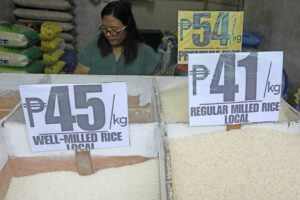




Philippines Trade Update: Trade trajectories trend along
 DOWNLOAD
DOWNLOAD

Policy Rate Updates: Double cut finale
 DOWNLOAD
DOWNLOAD

Monthly Economic Update: One for the road
 DOWNLOAD
DOWNLOAD


DoF eyes temporary zero tariffs on rice

The Department of Finance (DoF) is proposing to temporarily slash the tariff rates for rice imports to zero to curb the spike in retail prices of the national staple.
“We need to adopt a comprehensive approach to help ensure that rice supply remains sufficient at reduced prices,” Finance Secretary Benjamin E. Diokno said in a press chat on Friday.
He said the DoF proposed the “reduction of the 35% rice import tariff rates, both ASEAN (Association of Southeast Asian Nations) and MFN (Most Favored Nation) rates, temporarily to zero percent or maximum of 10% to arrest the surge in rice prices.”
This as inflation unexpectedly quickened to 5.3% in August from 4.7% in July, driven by the rise in pump prices and food costs, particularly rice.
The government began implementing a nationwide price ceiling on rice last week, as part of efforts to address increasing prices of the national staple amid reports of hoarding and price manipulation by cartels.
The ceiling is at PHP 41 per kilo for regular milled rice and PHP 45 per kilo for well-milled rice.
Mr. Diokno said price ceiling on rice would likely last only a month. He noted that price controls, if “closely implemented,” are effective in the near term.
“However, the government recognizes that it also has adverse effects if allowed to linger for a longer period. The President has directed the economic team to implement measures that will mitigate the negative impact of the price controls on rice retailers and farmers,” he said.
The Finance chief admitted he was “surprised” when Mr. Marcos first announced the price cap on rice on Sept. 1. At that time, Mr. Diokno was in Tokyo with National Economic and Development Authority Secretary Arsenio M. Balisacan, and Budget Secretary Amenah F. Pangandaman for the Philippines-Japan High-Level Joint Committee Meeting.
“We were in Japan when that was announced. I was beside Arsi (Mr. Balisacan). We were surprised, of course,” he said in mixed English and Filipino.
On the proposed cut in rice tariffs, Mr. Diokno said this can only be approved when Congress is in recess. Congress is set to adjourn on Sept. 30 and resume session on Nov. 6.
The tariff reduction will also only require an executive order (EO) for its implementation.
“There’s no need for Congress… The President may adjust the tariff when Congress is not in session,” he said. “There is just a hearing, then the Tariff Commission will recommend, it needs an EO. The Tariff Commission will draft an EO to the President.”
Mr. Diokno said the temporary tariff cut will only be applied to rice and not include the other MFN rates for pork, corn and coal.
“The relaxing of the tariff is forward-looking because the price of rice is going up globally… rice is really, I think, the biggest contributor to inflation,” he said.
Food inflation quickened to 8.2% in August from 6.3% in the previous month. This was partly driven by rice inflation, which surged to 8.7% in August from 4.2% in July.
Apart from the tariff cut, Mr. Diokno said the government is seeking “cooperation with tollway concessionaires and operators for the temporary exemption of trucks that cater to agricultural goods from the increase in toll fees.”
Mr. Diokno noted that this would mean trucks would still pay the regular toll, but not the recently adjusted increases.
“The private concessionaires agreed with the proposal, they’re just trying to define the guidelines on how to identify these delivery trucks,” Finance Undersecretary Zeno Ronald R. Abenoja said.
The Toll Regulatory Board (TRB) will be in charge of issuing the guidelines for the toll exemption, he added.
To curb rice price increases, Mr. Diokno said the government will encourage the timely importation of rice by the private sector and fully implement the Super Green Lane to expedite rice imports.
“There is also a need to curb noncompetitive behavior in the rice industry by aggressively pursuing cases of hoarding, smuggling, and economic sabotage; strictly monitoring the prices of imported rice in the logistics chain; and encouraging the public, including retailers, to report individuals violating price caps on rice,” Mr. Diokno said.
“At the same time, we have to pursue programs to protect vulnerable sectors by safeguarding our farmers from the effect of the price ceiling; provide targeted subsidies to small traders and retailers of rice; and provide support to low-income households to address the impact of the surge in rice prices,” he added.
The Department of Social Welfare and Development began distributing a PHP 15,000 cash subsidy to small rice retailers on Saturday.
Mr. Diokno said that there is a need for “timely, granular and accurate information on the status of the rice industry.”
“In this regard, the government must also devote more resources to satellite-based technology and data analytics to complement the dashboard,” he added.
This article originally appeared on bworldonline.com





 By BusinessWorld
By BusinessWorld